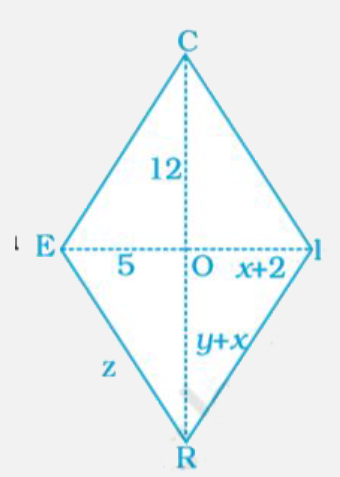Application on the problem solution strategy
Construct a rhombus with side 4.5cm and diagonal 6cm.
To construct a rhombus with a side length of 4.5 cm and a diagonal of 6 cm, follow these steps:
1. Draw the Base Side:
- Draw a line segment AB of length 4.5 cm. Label the endpoints as A and B.
Hint: Use a ruler to measure and draw the line accurately.
2. Locate the Center for the Diagonal:
- Since the diagonals of a rhombus bisect each other at right angles, we need to find the midpoint of AB. Label this midpoint as O.
Hint: To find the midpoint, measure 2.25 cm from point A to point O and 2.25 cm from point B to point O.
3. Draw the First Diagonal:
- From point O, draw a vertical line segment (the first diagonal) of length 6 cm. This means you will measure 3 cm upwards and 3 cm downwards from point O. Label the endpoints of this diagonal as C (above O) and D (below O).
Hint: Ensure that the line is perpendicular to AB by using a protractor or a set square.
4. Construct the Remaining Sides:
- Now, we will find points C and D. Since we already have points A and B, we need to connect points A to C and B to D.
- Measure 4.5 cm from A to C and from B to D to ensure that all sides of the rhombus are equal.
Hint: Use a compass set to 4.5 cm to mark arcs from points A and B to find points C and D accurately.
5. Complete the Rhombus:
- Connect points C and D to complete the rhombus ABCD.
Hint: Double-check that all sides are equal (4.5 cm) and that the diagonals intersect at right angles.
Final Result:
You have successfully constructed a rhombus ABCD with each side measuring 4.5 cm and one diagonal measuring 6 cm.
- Draw a line segment AB of length 4.5 cm. Label the endpoints as A and B.
- Since the diagonals of a rhombus bisect each other at right angles, we need to find the midpoint of AB. Label this midpoint as O.
- From point O, draw a vertical line segment (the first diagonal) of length 6 cm. This means you will measure 3 cm upwards and 3 cm downwards from point O. Label the endpoints of this diagonal as C (above O) and D (below O).
- Now, we will find points C and D. Since we already have points A and B, we need to connect points A to C and B to D.
- Measure 4.5 cm from A to C and from B to D to ensure that all sides of the rhombus are equal.
- Connect points C and D to complete the rhombus ABCD.
You have successfully constructed a rhombus ABCD with each side measuring 4.5 cm and one diagonal measuring 6 cm.
Topper's Solved these Questions
- UNDERSTANDING QUADRILATERALS AND PRACTICAL GEOMETRYBOOK - NCERT EXEMPLARCHAPTER - UNDERSTANDING QUADRILATERALS AND PRACTICAL GEOMETRYEXERCISE - EXERCISE
200 Videos
- UNDERSTANDING QUADRILATERALS AND PRACTICAL GEOMETRYBOOK - NCERT EXEMPLARCHAPTER - UNDERSTANDING QUADRILATERALS AND PRACTICAL GEOMETRYEXERCISE - APPLICATIONS, GAMES AND PUZZLES
3 Videos
- SQUARE - SQUARE ROOT AND CUBE-CUBE ROOTBOOK - NCERT EXEMPLARCHAPTER - SQUARE - SQUARE ROOT AND CUBE-CUBE ROOTEXERCISE - Exercise
52 Videos
- VISUALISING SOLID SHAPES BOOK - NCERT EXEMPLARCHAPTER - VISUALISING SOLID SHAPES EXERCISE - EXERCISE
91 Videos
Similar Questions
Construct a rhombus ABCD given that side AB=5 cm and a diagonal is 6 cm.
View SolutionConstruct a rhombus with the sides 4.5 cm and one of its angle is 60∘.
View SolutionConstruct a rhombus whose side is 5 cm and one angle is of 60°.
View SolutionConstruct a rhombus ABCD , given that side AB=6 cm and one diagonal is 7 cm.
View SolutionConstruct a rhombus PQRS with diagonal PR=3.4cm and QS=3.6cm.
View SolutionConstruct a rhombus PQRS with diagonal PR=3.4 cm and QS=3.6 cm.
View SolutionConstruct a rectangle ABCD in which side BC=5 cm and diagonal BD=6.2cm.
View Solution
RICE is a rhombus. Find x, y, z.

View SolutionConstruct a rectangle PQRS, in which PQ=5.5 cm and diagonal PR=6.4cm.
View SolutionConstruct a rhombus PQRS with diagonal PR=3.4 cm and QS=3.6 cm.
View Solution
